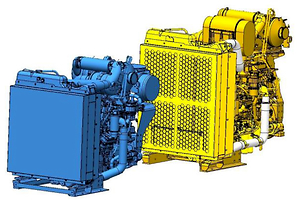REVIEW PAPER
Analysis of the selection of the auxiliary drive system for a special purpose hybrid rail vehicle
1
Łukasiewicz Research Network - Poznan Institute of Technology, Poland
2
Zakład Pojazdów Szynowych Sp. z o.o., Poland
Submission date: 2022-03-07
Final revision date: 2022-04-20
Acceptance date: 2022-04-23
Online publication date: 2022-05-03
Publication date: 2022-05-24
Corresponding author
Patryk Urbański
Łukasiewicz Research Network - Poznan Institute of Technology, Łukasiewicz Research Network - Poznan Institute of Technology, Warszawska 181, 61-055, Poznań, Poland
Łukasiewicz Research Network - Poznan Institute of Technology, Łukasiewicz Research Network - Poznan Institute of Technology, Warszawska 181, 61-055, Poznań, Poland
Rail Vehicles/Pojazdy Szynowe 2022,1-2,30-39
KEYWORDS
combustion enginespecial purpose vehiclealternative propulsion systemshybrid rail vehicleauxiliary drive system
TOPICS
ABSTRACT
Strict emission standards mean that the internal combustion engines used in means of transport must meet the standards for the emission of harmful compounds. For this reason, there is an increase in the use of alternative sources of propulsion, including rail transport. The article presents unconventional solutions of drive systems in rail vehicles using hybrid systems and fuel cells. The concept of the realizing project of a special-purpose rail vehicle, which is to be able to be driven from three different sources, was presented. Considerations concerning the selection of the internal combustion propulsion system, which is to be used as an auxiliary in the vehicle, are described. The possibilities of installing the power unit on the vehicle were also presented.
REFERENCES (28)
1.
Bartczak K. Analiza taboru kolejowego w Polsce. TTS Technika Transportu Szynowego. 2015, 22.
3.
Czerwiński J., Marciniak Z. Modułowe konstrukcje jedno- i dwukabinowych lokomotyw elektrycznych i spalinowych. Rail Vehicles/Pojazdy Szynowe. 2014, 1, 1-10. https://doi.org/10.53502/RAIL-....
4.
Daszkiewicz P., Rymaniak Ł., Medwid M. et al. Assessment of toxic compounds emission of rail-road tractor during works on tracks. Rail Vehicles/Pojazdy Szynowe. 2018, 4, 1-8. https://doi.org/10.53502/RAIL-....
5.
Doyle D., Harris A., Chege S. et al. Hydrogen fuel cell buses: modelling and analysing suitability from an operational and environmental perspective. SAE Technical Paper 2020-01-1172. https://doi.org/10.4271/2020-0....
6.
Durzyński Z. Hydrogen-powered drives of the rail vehicles (part 1). Rail Vehicles/Pojazdy Szynowe. 2021, 2, 29-40. https://doi.org/10.53502/RAIL-....
7.
Durzyński Z. Hydrogen-powered drives of the rail vehicles (part 2). Rail Vehicles/Pojazdy Szynowe. 2021, 3, 1-11. https://doi.org/10.53502/RAIL-....
8.
Far M., Gallas D., Urbański P. et al. Modern combustion-electric PowerPack drive system design solutions for a hybrid two-unit rail vehicle. Combustion Engines. 2021. https://doi.org/10.19206/CE-14....
9.
Gallas D., Stobnicki P. Adoption of modern hydrogen technologies in rail transport. Journal of Ecological Engineering. 2022, 23(3) 84-91. https://doi.org/10.12911/22998....
12.
Internet website: Internet website: Pesa walczy o kontrakt na lokomotywy. https://bydgoszcz.wyborcza.pl.
13.
Internet website: Internet website: Emission standards, EU: Nonroad Engines. https://dieselnet.com.
14.
Kalociński T. Modern trends in development of alternative powertrain systems for non-road machinery. Combustion Engines. 2022, 188(1), 42-54. https://doi.org/10.19206/CE-14....
15.
Konrad M., Jäger V., Pagenkopf J. et al. Concept and design of a shunting locomotive equipped with a hybridized fuel cell hydrogen powertrain. 2021 Sixteenth International Conference on Ecological Vehicles and Renewable Energies (EVER). 2021, 1-5. https://doi.org/10.1109/EVER52....
16.
Madovi O., Hoffrichter A., Little N. et al. Feasibility of hydrogen fuel cell technology for railway intercity services: a case study for the Piedmont in North Carolina. Railway Engineering Science. 2021, 29(3), 258-270. https://doi.org/10.1007/s40534....
17.
Merkisz J., Rymaniak Ł., Lijewski P. et al. Tests of ecological indicators of two-way vehicles meeting Stage IIIB and Stage IV standards in real operating conditions. Rail Vehicles/Pojazdy Szynowe. 2020, 1, 1-9. https://doi.org/10.53502/RAIL-....
18.
Merkisz J., Siedlecki M., Ziółkowski A. et al. Methods of reducing emission from HDV Euro VI engines. Combustion Engines. 2015, 162(3), 480-486.
19.
Michalak P., Jakuszko W. Innowacyjna uniwersalna lokomotywa dwunapędowa. Zeszyty Naukowo-Techniczne Stowarzyszenia Inżynierów i Techników Komunikacji w Krakowie. Seria: Materiały Konferencyjne. 2019, 2(119), 149-158.
20.
Michalak P., Merkisz J., Stawecki W. et al. The selection of the engine unit - main engine generator during the modernization of the 19D/TEM2 locomotive. Combustion Engines. 2020, 182(3), 38-46. https://doi.org/10.19206/CE-20....
21.
Muelaner J.E. Unsettled issues in electrical demand for automotive electrification pathways. SAE Research Report EPR2021004, 2021. https://doi.org/10.4271/EPR202....
22.
Oldknow K., Mulligan K., McTaggart-Cowan G. The trajectory of hybrid and hydrogen technologies in North American heavy haul operations. Railway Engineering Science. 2021, 29(3), 233-247. https://doi.org/10.1007/s40534....
23.
Orczyk M., Gis W., Tomaszewski F. Circumstances of railway transport hydrogenization in Poland. SAE Technical Paper 2020-01-2131, 2020. https://doi.org/10.4271/2020-0....
24.
Pertl P., Aggarwal M., Trattner A. et al. Development of hydrogen powered fuel cell e-snowmobiles. SAE Technical Paper 2019-32-0555, 2019.
25.
Rasiński T., Michnej M. Application of hybrid drives in diesel locomotives. Rail Vehicles/Pojazdy Szynowe. 2019, 1, 18-25. https://doi.org/10.53502/RAIL-....
26.
Shadidi B., Najafi G., Yusaf T. A review of hydrogen as a fuel in internal combustion engines. Energies. 2021, 14(19), 6209. https://doi.org/10.3390/en1419....
27.
Sun Y., Anwar M., Hassan N.M.S. et al. A review of hydrogen technologies and engineering solutions for railway vehicle design and operations. Railway Engineering Science. 2021, 29(3), 212–232. https://doi.org/10.1007/s40534....
28.
Urbański P., Gallas D., Kołodziejek D. et al. Passive safety features of a type 227M rail vehicle. Rail Vehicles/Pojazdy Szynowe. 2021, 4, 25-36. https://doi.org/10.53502/RAIL-....
We process personal data collected when visiting the website. The function of obtaining information about users and their behavior is carried out by voluntarily entered information in forms and saving cookies in end devices. Data, including cookies, are used to provide services, improve the user experience and to analyze the traffic in accordance with the Privacy policy. Data are also collected and processed by Google Analytics tool (more).
You can change cookies settings in your browser. Restricted use of cookies in the browser configuration may affect some functionalities of the website.
You can change cookies settings in your browser. Restricted use of cookies in the browser configuration may affect some functionalities of the website.




